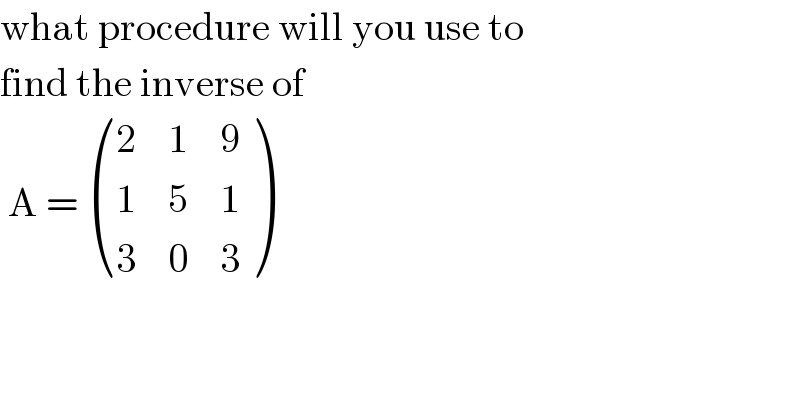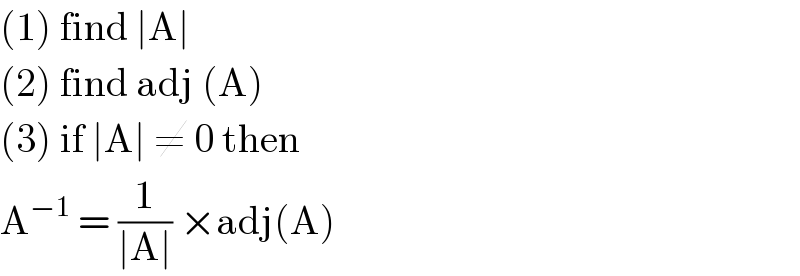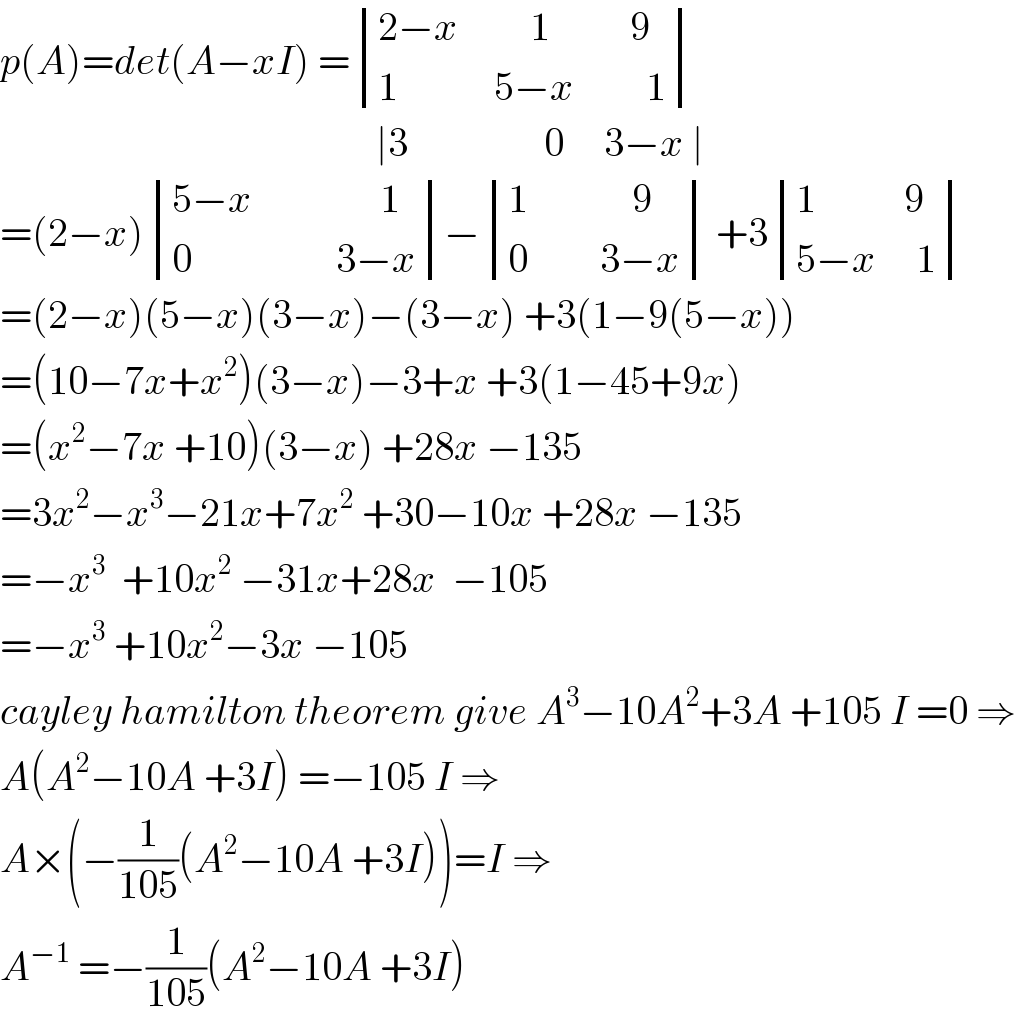
Question Number 85131 by Rio Michael last updated on 19/Mar/20

$$\mathrm{what}\:\mathrm{procedure}\:\mathrm{will}\:\mathrm{you}\:\mathrm{use}\:\mathrm{to}\: \\ $$$$\mathrm{find}\:\mathrm{the}\:\mathrm{inverse}\:\mathrm{of} \\ $$$$\:\mathrm{A}\:=\:\begin{pmatrix}{\mathrm{2}}&{\mathrm{1}}&{\mathrm{9}}\\{\mathrm{1}}&{\mathrm{5}}&{\mathrm{1}}\\{\mathrm{3}}&{\mathrm{0}}&{\mathrm{3}}\end{pmatrix} \\ $$
Commented by jagoll last updated on 19/Mar/20

$$\left(\mathrm{1}\right)\:\mathrm{find}\:\mid\mathrm{A}\mid\: \\ $$$$\left(\mathrm{2}\right)\:\mathrm{find}\:\mathrm{adj}\:\left(\mathrm{A}\right) \\ $$$$\left(\mathrm{3}\right)\:\mathrm{if}\:\mid\mathrm{A}\mid\:\neq\:\mathrm{0}\:\mathrm{then} \\ $$$$\mathrm{A}^{−\mathrm{1}} \:=\:\frac{\mathrm{1}}{\mid\mathrm{A}\mid}\:×\mathrm{adj}\left(\mathrm{A}\right) \\ $$
Commented by Rio Michael last updated on 19/Mar/20

$$\mathrm{thanks} \\ $$
Commented by mathmax by abdo last updated on 19/Mar/20

$${p}\left({A}\right)={det}\left({A}−{xI}\right)\:=\begin{vmatrix}{\mathrm{2}−{x}\:\:\:\:\:\:\:\:\:\mathrm{1}\:\:\:\:\:\:\:\:\:\:\mathrm{9}}\\{\mathrm{1}\:\:\:\:\:\:\:\:\:\:\:\:\mathrm{5}−{x}\:\:\:\:\:\:\:\:\:\mathrm{1}}\end{vmatrix} \\ $$$$\:\:\:\:\:\:\:\:\:\:\:\:\:\:\:\:\:\:\:\:\:\:\:\:\:\:\:\:\:\:\:\:\:\:\:\:\:\:\:\:\:\:\:\:\:\:\:\mid\mathrm{3}\:\:\:\:\:\:\:\:\:\:\:\:\:\:\:\:\:\mathrm{0}\:\:\:\:\:\mathrm{3}−{x}\:\mid \\ $$$$=\left(\mathrm{2}−{x}\right)\begin{vmatrix}{\mathrm{5}−{x}\:\:\:\:\:\:\:\:\:\:\:\:\:\:\:\:\mathrm{1}}\\{\mathrm{0}\:\:\:\:\:\:\:\:\:\:\:\:\:\:\:\:\:\:\mathrm{3}−{x}}\end{vmatrix}−\begin{vmatrix}{\mathrm{1}\:\:\:\:\:\:\:\:\:\:\:\:\:\mathrm{9}}\\{\mathrm{0}\:\:\:\:\:\:\:\:\:\mathrm{3}−{x}}\end{vmatrix}\:+\mathrm{3}\begin{vmatrix}{\mathrm{1}\:\:\:\:\:\:\:\:\:\:\:\mathrm{9}}\\{\mathrm{5}−{x}\:\:\:\:\:\mathrm{1}}\end{vmatrix} \\ $$$$=\left(\mathrm{2}−{x}\right)\left(\mathrm{5}−{x}\right)\left(\mathrm{3}−{x}\right)−\left(\mathrm{3}−{x}\right)\:+\mathrm{3}\left(\mathrm{1}−\mathrm{9}\left(\mathrm{5}−{x}\right)\right) \\ $$$$=\left(\mathrm{10}−\mathrm{7}{x}+{x}^{\mathrm{2}} \right)\left(\mathrm{3}−{x}\right)−\mathrm{3}+{x}\:+\mathrm{3}\left(\mathrm{1}−\mathrm{45}+\mathrm{9}{x}\right) \\ $$$$=\left({x}^{\mathrm{2}} −\mathrm{7}{x}\:+\mathrm{10}\right)\left(\mathrm{3}−{x}\right)\:+\mathrm{28}{x}\:−\mathrm{135} \\ $$$$=\mathrm{3}{x}^{\mathrm{2}} −{x}^{\mathrm{3}} −\mathrm{21}{x}+\mathrm{7}{x}^{\mathrm{2}} \:+\mathrm{30}−\mathrm{10}{x}\:+\mathrm{28}{x}\:−\mathrm{135} \\ $$$$=−{x}^{\mathrm{3}} \:\:+\mathrm{10}{x}^{\mathrm{2}} \:−\mathrm{31}{x}+\mathrm{28}{x}\:\:−\mathrm{105} \\ $$$$=−{x}^{\mathrm{3}} \:+\mathrm{10}{x}^{\mathrm{2}} −\mathrm{3}{x}\:−\mathrm{105} \\ $$$${cayley}\:{hamilton}\:{theorem}\:{give}\:{A}^{\mathrm{3}} −\mathrm{10}{A}^{\mathrm{2}} +\mathrm{3}{A}\:+\mathrm{105}\:{I}\:=\mathrm{0}\:\Rightarrow \\ $$$${A}\left({A}^{\mathrm{2}} −\mathrm{10}{A}\:+\mathrm{3}{I}\right)\:=−\mathrm{105}\:{I}\:\Rightarrow \\ $$$${A}×\left(−\frac{\mathrm{1}}{\mathrm{105}}\left({A}^{\mathrm{2}} −\mathrm{10}{A}\:+\mathrm{3}{I}\right)\right)={I}\:\Rightarrow \\ $$$${A}^{−\mathrm{1}} \:=−\frac{\mathrm{1}}{\mathrm{105}}\left({A}^{\mathrm{2}} −\mathrm{10}{A}\:+\mathrm{3}{I}\right) \\ $$
Commented by mathmax by abdo last updated on 19/Mar/20

$${also}\:{we}\:{can}\:{use}\:{A}^{−\mathrm{1}} \:=\frac{{t}\left({comA}\right)}{{detA}}\:\:\:{this}\:{method}\:{is}\:{simple}... \\ $$
